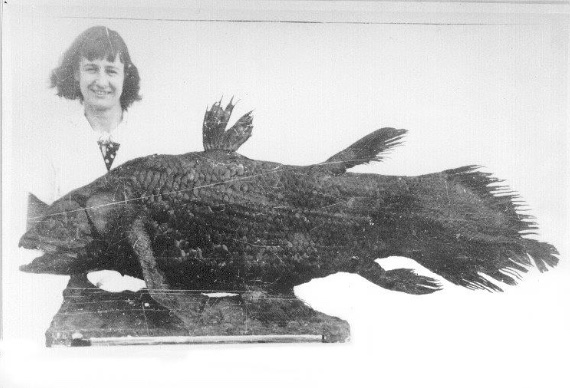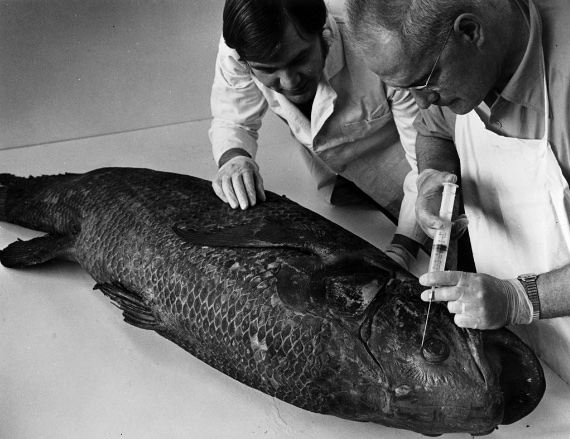In 1938, one of the most valuable zoological finds in history would have been lost but for the determination of one woman. Against all odds, the South African naturalist Marjorie Courtenay-Latimer managed to conserve a rare fish that she could not identify, but in which she sensed a great discovery. The coelacanth (pronounced see-luh-kanth), named Latimeria Chalumnae in her honour, was not only the celebrated rediscovery of a lineage of animals thought to be extinct since the debacle that wiped out the dinosaurs, but also provided scientists with new clues to understanding evolution.
Courtenay-Latimer (24 February 1907 – 17 May 2004) was born in East London, then a growing port town in the Cape Colony of the British Empire. Many of its residents of European descent were settlers seeking a new life. Such was the case of Eric Courtenay-Latimer, who was born in British India and emigrated to South Africa, where he served in the Anglo-Boer War, later became an (unsuccessful) diamond prospector and finally settled as a railway station master. His wife, Willie Fulton, was a widow with two daughters and had six more with her new husband. The eldest of these, Marjorie Eileen Doris, seemed destined for a very short life: born two months premature, she weighed less than a kilo and had no fingernails or toenails. She was so tiny that the doctor placed her in a shoebox, where she was fed with an eyedropper and dressed in doll’s clothes.

Against all odds, Marjorie survived, in fragile health throughout her childhood, but with a fierce will to live. As the ichthyologist Susan Jewett has written from Marjorie’s own account, she suddenly began to walk at seven months, and not long afterwards surprised her parents by speaking German, the language of some of the children in her neighbourhood. A nature-loving child, she tended to get into trouble with her favourite sister, Norah; she had run-ins with a cobra and an escaped Bengal tiger from the local zoo, and she collected birds’ nests and eggs. One day, distracted in class, her teacher, Sister Camilla, punished her inattention by making her write down 25 times the explanation Marjorie wasn’t listening to: “A fossil fish has ganoid scales; a fossil fish has limb-like fins.”
The foremost expert on local wildlife
Her love of animals, especially birds, would lead her to abandon her nursing studies when she heard of a job offer as a curator at the newly established East London Museum. In August 1931, her knowledge of local wildlife won her the job over more qualified candidates. For 15 years, she and a Xhosa assistant, Enoch Thwate, were the only staff at the museum, and were solely responsible for procuring items to stock the collection. Then, on 22 December 1938, she received a phone call: a fisherman she knew, Captain Hendrik Goosen, had caught some specimens that he thought might be of interest.
Marjorie was reluctant to go to the harbour, as she was preparing an important fossil reptile for display in the museum, but Christmas was approaching, and she felt she had to repay Goosen’s kindness in helping her take some specimens to the museum aboard his ship a few years earlier. Her trip to the harbour was certainly worthwhile: “I picked away at a layer of slime to reveal the most beautiful fish I had ever seen,” she would later recall. The 1.5-metre, almost 60-kilogram specimen had hard scales and four fins that looked like legs. And then Marjorie remembered the lines she had had to write for Sister Camilla.

After persuading the taxi driver to let her load the smelly fish into the back of his cab, she was unable to identify it from the few reference books she had. The chairman of the museum’s board told her it was a common rock cod and to throw it away. But Marjorie knew better. Determined to preserve the decomposing fish, she wrote to the chemist and ichthyologist J.L.B. Smith, whom she had met during her fieldwork, enclosing a drawing. In the meantime, she could only turn to a part-time taxidermist, who managed to preserve the animal but discarded its internal organs.
The living fossil debate
Marjorie’s drawing revealed to Smith a fish unlike any he had ever seen: “It looked more like a lizard,” he wrote in his 1956 book Old Fourlegs: The Story of the Coelacanth. But he soon had his eureka moment: it looked very similar to fish known only from fossils, which had gone extinct millions of years ago. When he finally got through to Marjorie, he urged her to keep the organs. She tried to retrieve them from the municipal dump, but to no avail.
The rest is well known: the coelacanth, which existed more than 400 million years ago and was thought to have died out at the end of the Cretaceous period, had in fact been hidden from science for 66 million years. It would be almost 15 years before a second specimen was found, this time in the Comoros Islands in the Indian Ocean. Two species are now known, both belonging to the genus that Smith had named in honour of its discoverer, even before he laid eyes on the preserved fish.

But although it was then called a “living fossil”, a term coined by Darwin and still used today, some scientists—but not all—consider this to be a misnomer, since both the coelacanth and other organisms that appear to resemble their ancestral forms have also evolved; today’s coelacanths are similar to the prehistoric ones, but they are distinct genera that would not have successfully reproduced with each other. Their genomes have been used to better understand the natural history of these species and the transition from aquatic to terrestrial animals. A more appropriate term for the coelacanth is “Lazarus taxon“, species that were thought to have disappeared and that, like the biblical character, have been resurrected for science; to use another, more modern term, as resilient as Marjorie herself, the little girl born two months premature who lived to be 97 years old.
Javier Yanes
Comments on this publication